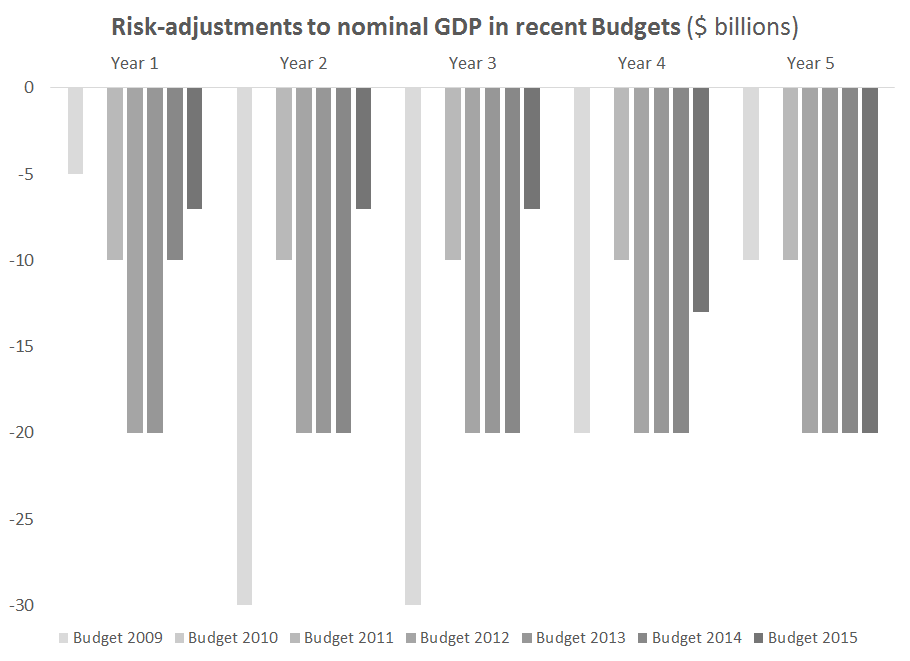
The Liberals’ election platform calls for a fiscal planning approach that is “realistic, sustainable, prudent, and transparent.”
In Budget 2016, I suspect the new government (much like previous governments) will want to show that its approach to budgeting is different than its predecessors. Here are four concrete suggestions to enhance the credibility of our fiscal policy presentation and processes:
1. Box it up: more budget details please
There are often arcane budget details that matter, but only for a handful of budget readers. If you include these details in the main text, you risk boring the average reader; but if you leave them out, experts will wonder if those in charge of the budget have examined the details.
The answer is to include a stand-alone “box” (much like an extended footnote) that provides details and numbers for those interested few, while allowing everyone else to avoid this rabbit hole. As a candidate, here’s a particularly important but opaque paragraph from the December update alluding to the impact of interest rates changes on pension benefits.
Direct program expenses are expected to be higher than projected in Budget 2015, largely as a result of higher projected public service pension and benefit expenses. Long-term interest rates are used in the valuations of the Government’s liabilities for employee pensions and other future benefits. While the total pension and benefit obligation of the Government has not changed, lower projected interest rates result in relatively more of these costs being recognized in the near term rather than the future.
For most readers this is more than they need. But for those few who want to know how this actually works, they’d like to see some numbers. Another example would be to include a box that has a more detailed theoretical and numerical explanation of the channels by which lower oil prices impact the federal government’s bottom line.
2. Show low-for-long oil: present an alternative scenario to the central forecast
For over two decades, when preparing its budget, the federal government has used economic assumptions from the average of private sector forecasts.
This is a defensible approach. Unfortunately, there are times when averaging a bunch of independent forecasts doesn’t provide a sensible basis for budget planning.
Finance officials understand this problem, and so they don’t always just take the economic survey average and translate this economic outlook into their budget numbers.
Occasionally, they make adjustments. This has been done in various ways over the years: sometimes using “contingency reserves” and “economic prudence” factors that are taken off the government’s bottom line.
Sometimes adjustments are made directly to nominal GDP — as in six of the last seven budgets, see the figure below — in order to reflect downside risks to the economic outlook and inject some caution into the budget projections.
 With private sector forecasts in Canada repeatedly being revised down in recent months, expect the government to once again make some type of downward risk adjustment in Budget 2016.
With private sector forecasts in Canada repeatedly being revised down in recent months, expect the government to once again make some type of downward risk adjustment in Budget 2016.
However, in addition to making the usual ad hoc adjustments to nominal GDP or contingency reserve, here’s a prudent scenario that’s worth reporting that might convey a better sense of downside risks for the Canadian economy: Report a separate budget outlook that assumes the price of oil stays at $30/barrel for the next five years (and the associated macroeconomic variables that would be broadly consistent with this, for the GDP deflator, interest rates, unemployment rate, etc.)
Previous Bank of Canada Monetary Policy Reports and a staff analytical note have reported similar exercises. The basic idea is to use a detailed forecasting model to describe the size of the recent economic shock and its impacts. This could show ballpark estimates of the outlook for the Canadian economy and the federal budget, under the assumption that fiscal policy remained in status quo mode and took no actions to offset the oil price shock.
Such a scenario would be instructive, as it could demonstrate to readers that the federal budget is perhaps not as sensitive to lower commodity prices as some fear (since there are generally some fiscal offsets, such as lower interest rates, and less spending pressures in some areas due to weaker inflation, etc). Conversely, it might also show that without some fiscal stimulus, the Canadian economy will likely remain below its productive capacity for several years.
The point here is that the budget document is not only a place for the government to extol the virtues of its policy choices, it should also provide interested readers genuine insight in the government’s fiscal situation and policy options.
3. Publish or perish: release more Finance Canada working papers
Many years ago, when I worked at Finance there was an active research department and external publication stream. (I can’t find it on the department’s website, but here’s a link of achieved papers.)
Economists should be encouraged to publish their analytical work, and to present it at conferences. If the government wants to “unmuzzle” its scientists, then let’s not forget the economists while we’re at it. Students and scholars will be able to read the analysis. These publications will promote knowledge exchange and build the internal analytical capacity of the department. Publishing papers with titles like, Taxation and Economic Efficiency: Results from a Canadian CGE Model, takes time and may seem to offer little short-run payoff (and perhaps some media risk). But over this long run, this is the way to strengthen the evidence base for policy-making and build the human capital of Finance Canada officials.
4. Fill the Clifford Clark Visiting Economist position
Further to the importance of knowledge exchange, Finance Canada has a long-standing position (the Clifford Clark Visiting Economist) which was previously held by esteemed people such like Chris Ragan, Jack Mintz and Doug Purvis, among others.
Unfortunately, this post has been vacant for much of the last five years. Ideally, it would be filled by someone who is a professor at a university, active in research on Canadian fiscal policy. And for a government that emphasized the importance of gender parity for its cabinet, there’s a strong case for hiring a female for this role. After 12 men in a row, maybe it’s time for a change that would help signal there’s value in the input from our best and brightest female economists in Canada.







